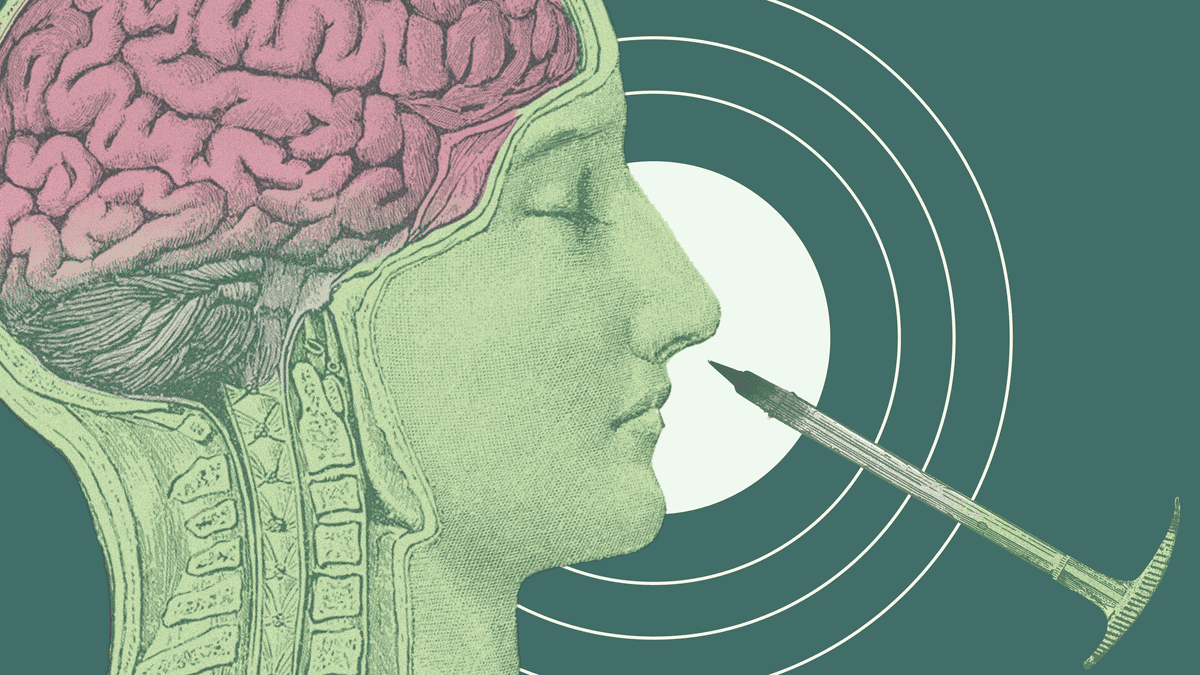Should You Have a Lobotomy?
To start with: No. You should not have (or perform) a lobotomy. It would be impossible to find a surgeon willing to take on the procedure, and whatever is wrong with you would be better handled through other means....

To start with: No. You should not have (or perform) a lobotomy. It would be impossible to find a surgeon willing to take on the procedure, and whatever is wrong with you would be better handled through other means. Hypothetically, however, you could have a friend perform a lobotomy on you with a few tools and without great difficulty—if there was ever a DIY brain surgery, it’s the transorbital lobotomy. If you live through it, you probably won’t even be unhappy with the results of the procedure, but only because there won’t be much of “you” left to care.
What is a lobotomy?
A lobotomy (or leukotomy) is a surgical procedure in which the prefrontal lobe is physically separated from the rest of the brain by cutting the nerves that connect them. It was developed in the 1930s by Portuguese neurologist António Egas Moniz, who won the the Nobel Prize for Medicine in 1949 for his work. Mainly used to treat major depressive disorder, obsessive compulsive disorder, and sometimes schizophrenia, an estimated 50,000 lobotomies were performed in the United States, most between 1949 and 1952, but the procedure was still practiced here until the late 1960s.
For the theory behind how surgery helps people with mental illnesses, I’ll defer to psychiatrist Richard L. Jenkins, who wrote the following in his paper “Effects of prefrontal lobotomy on patient with severe chronic schizophrenia,” published in the American Journal of Psychiatry in 1954:
The hypothesis is presented that the splitting of the schizophrenic process is the result of a conflict, unresolvable to the patient…on the neurological side, by an unresolving morbid resonance or eddy of neural activity between cortex and diencephalon, which jams the higher circuits.
“Morbid resonance?” An “eddy” that “jams the higher circuits”? Sounds like legitimate neuroscience to me; let’s cut up some brains!
The supposed benefits of a lobotomy
Under breathless headlines like “Wizardry of Surgery Restores Sanity to Fifty Raving Maniacs,” the popular press of the 1940s and ‘50s cast the lobotomy as a miracle cure for mental illness. After an outpatient procedure that could be finished in an hour, patients who had been institutionalized for decades were able to return home to their families and lead productive lives. People wracked with anxiety became carefree. Violent patients became docile. Once severely depressed people smiled all day long.
But the Saturday Evening Post and other publications left something out of their glowing descriptions of the benefits of lobotomies: The procedure often obliterates victims’ personalities and identities.
The many downsides of lobotomies
The prefrontal cortex of the brain is the part of us that plans complex cognitive behavior. It’s the source of personality expression, decision making, and moderating social behavior. In essence, the prefrontal lobe is what makes us human, so people who have it severed from the rest of their brains change drastically. According to neurologist and lobotomist pioneer Dr. Walter Freeman, the “personality of the patient is changed in some way in the hope of rendering him more amenable to the social pressures under which he is supposed to exist.” And a lobotomy does do that (if you don’t die from it), but the life of the lobotomized is not one many aspire towards.
Freeman called the post-lobotomy state “surgically induced childhood,” but that doesn’t do it justice. Lobotomized patients became smiling blank slates—agreeable, uncomplaining, but unable to dress themselves, unwilling to leave their beds, and seemingly incapable of introspection or self awareness. Freeman reported that about 25% of his patients stayed like that (at the level of a “household pet,” in his words), but with time, some were able to learn to perform menial tasks or even regained the ability to do simple math. Some relapsed and their symptoms returned. Some reportedly recovered and their symptoms disappeared. About 14% of patients simply died from the procedure.
While never widely accepted by the medical community, the lobotomy was popular in mental institutions, and it’s easy to understand why: It makes people compliant. In his 1950 book Psychosurgery, Freeman illustrated this with a description of Oretha, an institutionalized patient who required five attendees to hold her down for her pre-lobotomy anesthesia. Afterwards, “We could playfully grab Oretha by the throat, twist her arm, tickle her in the ribs and slap her behind without eliciting anything more than a wide grin or a hoarse chuckle,” Freeman wrote. Yay?
Severely mentally ill patients weren’t the only people to receive lobotomies, though. Freeman performed the surgery on wives who didn’t want to clean any more, 12-year-old children who daydreamed too much and stole candy, and many others. The most famous of these was Rosemary Kennedy.
At age 23, the often rebellious sister of President John F. Kennedy was living in a Washington, D.C. convent school. After Rosemary was caught sneaking out at night, the school’s nuns became concerned she might be involved with sexual partners. Her father, Joe Kennedy, took Rosemary to Freeman, who performed her lobotomy in November 1941.
Whether it worked or not depends on your point of view. Freeman initially called the operation a success, and Rosemary did lose the desire to sneak out at night, but she also lost the ability to speak and walk. Over years, Rosemary partially recovered, but she never spoke clearly again, and was never well enough to care for herself. In 1949, she was moved to a special cottage at the St. Coletta School for Exceptional Children (formerly known as “St. Coletta Institute for Backward Youth”), where she stayed until she died in 2005.
But enough history; let’s get to the brain surgery!
Step-by-step lobotomy instructions that you should absolutely never follow, and I shouldn’t have to tell you that
Nobel prize winner (I can’t get over that) António Egas Moniz’s original lobotomies involved drilling holes in the skull and flooding specific regions of the brain with alcohol to kill the tissue there—not something you can or should do at home. Luckily, Freeman, the P.T. Barnum of the lobotomy, pioneered the transorbital lobotomy, a simplified procedure that didn’t even require an operating room; he eschewed the formality and sterility of operating rooms, and would just lobotomize patients anywhere. In fact, it’s so efficient, Freeman could finish a lobotomy in under 10 minutes. Fun fact: Freeman had no formal surgical training.
These instructions are taken from Walter Freeman’s Psychosurgery by way of Jack El-Hai’s excellent biography The Lobotomist. If you were to follow them, you would be guilty of multiple crimes and someone would probably die.
The supplies needed
An icepickA small hammerAn electroconvulsive therapy machineThe procedure
To perform a lobotomy, Freeman would:
Sterilize his icepick. Usually. Sometimes he didn’t bother.Administer shocks of high-enough voltage to induce unconsciousness with an electroconvulsive therapy machine. Sometimes Freeman did it with no anesthesia, however. Slide the icepick beneath the victim’s upper eyelid, next to the tear duct, keeping the shaft parallel to the bony ridge of the nose and aimed slightly away from the center of the head. The tip of the icepick would now be resting against the thinnest portion of the skull. Freeman would give a light tap with a hammer to break through the bone. Now he would be able to easily push the icepick into the brain. Freeman advised going 5cm deep. Not too deep, or the “patient” would probably die.Pull the handle of the icepick “as far laterally as the rim of the orbit will permit.” This should sever the fibers at the base of the frontal lobe. Hopefully.According to Freeman, this step is the “ticklish part” because arteries are in reach. He would return the instrument to its previous position and drive it further to a depth of 7cm from the margin of the upper eyelid. Then move the ice pick 15 to 20 degrees medially and about 30 degrees laterally. If this was done wrong, the person would die. If done correctly, they’d only maybe die.Withdraw the icepick with a twisting motion while applying pressure on the eyelid to prevent hemorrhage.Resterilize the icepick. Repeat with the other eye. A true showman, Freeman would sometimes do both sides at once.The lobotomy is now complete!What happened to the lobotomy?
The lobotomy became less and less popular in psychiatric circles through the 1950s, partly because it’s horrific and doesn’t usually work anyway, but also because new discoveries in psychoactive drugs would placate troublesome people without all the brain-cutting. Why perform surgery when thorazine will do? Despite growing apprehension about the procedure, Freeman continued on with his lobotomies until 1967, when the last institution that let him perform the procedure finally said, “enough” after he killed a woman there.
The lobotomy isn’t completely dead, though. A modified, vastly refined version of the procedure is still in use today. The temporal lobectomy is used to treat severe cases of epilepsy that don’t respond to drugs. While it’s a far cry from Freeman’s “stick a needle in their brain and wiggle it around it” method, the basic idea is the same; it’s just targeted and as minimally invasive as possible now. It also has much better results: Patients generally come out of it with lessening of symptoms of epilepsy and with their personalities intact.

 Astrong
Astrong 
































